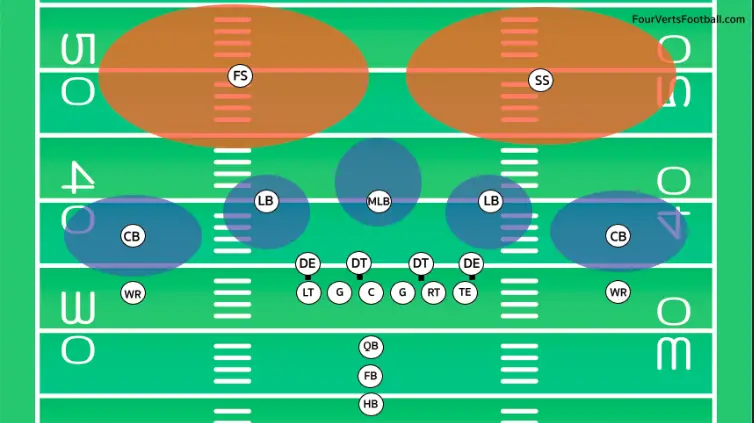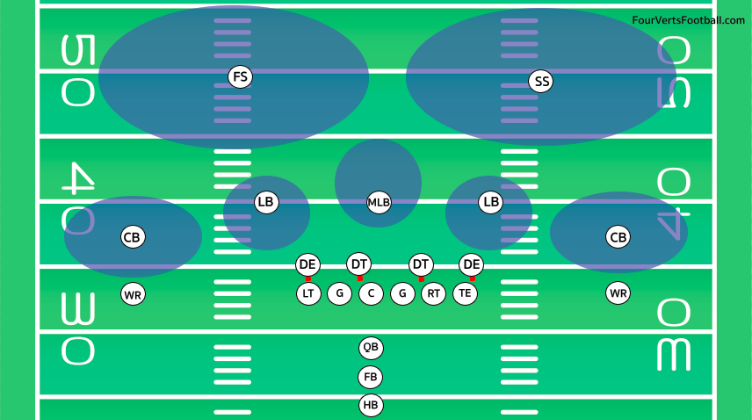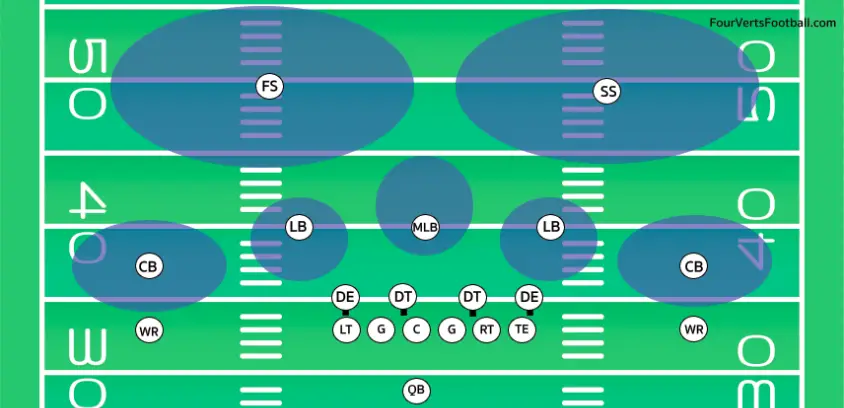Cover 2 in football is a zone defense which earns its name due to the two safeties that play deep into the defensive backfield. Cover 2 involves four players pass-rushing, five players playing underneath zones and two safeties covering the deep portions of the field.
The success of this defense largely relies on the safety’s ability to cover large portions of the field.
This cover 2 defense also requires the four pass rushers to provide pressure on the quarterback. If given too much time in the pocket a quality passing offense is going to beat a zone defense.
How it works
To get the best understanding of how a cover 2 defense works you must know how each defensive player is contributing to the play.
Below we will cover each position group so you can understand exactly what each player does in a cover 2 defense.
Safeties

In this defense safeties will line up 15-18 yards off the line of scrimmage. The deep portion of the field will be split between the two safeties.
This means the strong safety (SS) has to cover one half of the defensive backfield and the free safety (FS) has to cover the other half.
These players will be playing a zone defence meaning they must stop passes from being completed in their assigned area. This is different from man coverage in which a specific player is covered for the duration of the play.
If more than one player comes into a safety’s deep zone one of the other defenders should follow the receiver to help the safety out.
A large portion of this defense’s effectiveness relies on the safeties effectively covering the deep portion of the field.
For this reason, teams will often try and exploit the safety by sending multiple players deep downfield.
Cornerbacks

In a cover 2 defense cornerbacks are going to play a shallow zone that covers the area from the line of scrimmage to 5-7 yards deep on their side of the field.
Generally, cornerbacks playing in a cover 2 are going to play press coverage against the wide receivers. This means they are going to line up right in front of the receiver on the line of scrimmage.
The cornerbacks then have to jam the receiver so they do not get a clean release outside. This means the cornerback will get physical with the receiver to start the route in an attempt to force them to the inside of the field.
If the receiver is able to start the route with a quick-release near the sideline the safety is going to be in trouble. They will have to move towards the sideline to cover the wide receiver.
This leaves the middle of the field open as the safety who has moved to the sideline can no longer cover this portion of his zone.
For this reason, cornerbacks need to slow the receiver and move him inside to start the play. Once the receiver is down the field the cornerback will resume playing zone coverage.
The cornerback’s zone will often involve short passes to the running back or tight end.
Ideally, the cornerback will break these passes up. Though if completed they are not going to result in a very big play for the offense.
Linebackers

The linebackers in a cover 2 defense are going to all play a zone defense at a similar depth to the cornerback.
The three linebackers will cover the middle of the field roughly five to seven yards back from the line of scrimmage.
The middle linebacker will sometimes play a deeper zone in order to help the safeties out in the middle of the field.
Oftentimes teams will try to exploit a cover two defense with a quick pass down the middle of the field between the safeties.
The middle linebacker must play deep enough that the quarterback is not able to get the pass over top of him.
The middle or Mike linebacker will often play the deepest zone in the defense aside from the two safeties.
Defensive line

The defensive line are the players whose assignments are easiest to understand in a cover 2 defense.
On this play, all players on the defensive line will rush the quarterback. Since this defense is primarily run in a 4-3 formation there are going to be four players on the defensive line.
The cover two defensive line will include two defensive ends and two defensive tackles. These players need to get pressure on the quarterback in order to force him to throw.
If given too much time receivers are often able to find holes in a zone defense making it easy for their quarterback to complete passes.
There are rarely blitzes in this defense meaning these four defensive linemen are going to be the only players providing pressure on the quarterback.
This usually means a team is going to need some good edge rushers to run the cover two defense effectively.
Variations of cover 2
Cover 2 Man
The cover two man defense is very similar to the cover 2 defense the main difference being man and zone coverage. In a cover 2 the cornerbacks and linebackers are going to play an underneath zone coverage.
In a cover two man these players will play man coverage. The three linebackers and two cornerbacks will match up against specific players on the offense.
These defensive players will then cover the offensive player they are matched up with for the entire play.
The cornerbacks are almost always going to be matched up against the wide receivers lined up on the outside. The linebackers will generally be matched up with tight ends or running backs.
The two safeties will have the same assignment of covering the two deep halves of the field. If a player ends up going deep downfield against a cover two defense they will likely find themselves in double coverage.
One defender is the player in man coverage and the other is the safety covering his zone.
Effective plays against cover 2 defense
Now that you know how the cover 2 defense works in football you may be wondering what sort of plays work against it.
Below we will cover some of the common strategies used to beat this defense.
Four verticals
One of the most common ways to beat a cover two defense in football is to run four receivers deep downfield. This play is also our site’s namesake.
In this play, four different receivers are going to run vertical routes straight down the field.
The reason a play like this is so successful against a cover 2 defense is that it overwhelms the safeties.
Remember in a cover 2 there are only two safeties protecting the deep portion of the field.
If several receivers are able to get into this deep portion of the field one of the safeties is going to find himself with two receivers in his zone.
On these plays, linebackers may be asked to complete a pattern read. This means they will try and keep an eye out for other players running deep routes towards the safety.
If these realize a player has already gone deep into that safety’s zone then they will follow any additional receivers into the deep zone as well.
This helps the safety from having to cover two players by themselves.
Flat route plus corner route
Another common play that is used to beat a cover two defense is a combination of a flat route and a corner route.
In this defense the cornerback is assigned with covering the receiver to start the play. The cornerback must then cover the area five to seven yards off the line of scrimmage on their side of the field.
Offenses will take advantage of this cornerback by baiting him with one route and throwing to the other.
A running back or tight end will run a flat route causing the defender to move closer to the line of scrimmage.
Once the cornerback is closer to the line of scrimmage the wide receiver will have already run his corner route.
This corner route will put the receiver near the sideline and underneath the safety. Since the cornerback is close to the line of scrimmage they will not be able to stop the pass to the wide receiver.
This play can be especially helpful in the two-minute drill when the offense is looking to stop the clock.

